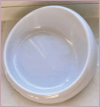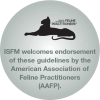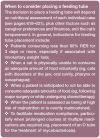2022 ISFM Consensus Guidelines on Management of the Inappetent Hospitalised Cat
- PMID: 35775307
- PMCID: PMC11107985
- DOI: 10.1177/1098612X221106353
2022 ISFM Consensus Guidelines on Management of the Inappetent Hospitalised Cat
Erratum in
-
Erratum to '2022 ISFM Consensus Guidelines on Management of the Inappetent Hospitalised Cat'.J Feline Med Surg. 2023 Feb;25(2):1098612X221149867. doi: 10.1177/1098612X221149867. J Feline Med Surg. 2023. PMID: 36779793 Free PMC article. No abstract available.
Abstract
Practical relevance: Inappetence may have many origins and, as a presenting sign or observation in the hospitalised patient, is common in feline practice. Nutritional assessment of every patient is encouraged, to identify the need for, and appropriate type of, intervention indicated. The impact of malnutrition may be significant on the feline patient, perpetuating illness, delaying recovery, slowing wound healing and negatively impacting gut health and immunity. Delayed intervention may result in the cat's deterioration; hence prompt control of contributing factors such as the underlying illness, pain, nausea, ileus and stress is vital to optimise voluntary food intake. Management is multimodal, comprising reduction of stress, medications and assisted nutrition in the form of tube feeding or parenteral nutrition. Use of antiemetic, analgesic, prokinetic and appetite stimulant medications may restore appetite, but placement of feeding tubes should not be delayed. Feeding tubes are generally well tolerated and allow provision of food, water and medication with minimal stress, although clinicians must be aware of complications such as stoma site infections and refeeding syndrome.
Clinical challenges: Cats are vulnerable to malnutrition owing to their unique metabolism and specific nutritional requirements. Moreover, their nature as a species means they are susceptible to stress in the hospital environment, which may result in reduced food intake; previous negative experiences may compound the problem. In particular, an inappropriate clinic environment and/or handling may cause or exacerbate inappetence in hospitalised patients, with negative impacts on recovery. Postponing interventions such as feeding tube placement to await improvement, owing to clinician or caregiver apprehension, may hinder recovery and worsen nutritional deficits.
Evidence base: The 2022 ISFM Consensus Guidelines on Management of the Inappetent Hospitalised Cat have been created by a panel of experts brought together by the International Society of Feline Medicine (ISFM). Information is based on the available literature, expert opinion and the panel members' experience.
Keywords: Feeding tubes; anorexia; appetite stimulants; gastrostomy; hyporexia; naso-oesophageal; nasogastric; nutritional assessment; nutritional support; oesophagostomy; refeeding syndrome.
Conflict of interest statement
Franck Peron is an employee of Royal Canin. Jessica Quimby is a consultant for a variety of companies including Dechra, Elanco, Boehringer Ingelheim, Vetoquinol, Zoetis, Purina, Hill’s and Royal Canin. Sam Taylor has worked for various pet food and pharmaceutical companies on a consultancy basis. Cecilia Villaverde has done consulting work for a variety of pet food companies. She develops educational materials for Mark Morris Institute, sits on the scientific advisory board of FEDIAF and is a member of the Global Nutrition Committee of the WSAVA. She participates as a speaker in continuing education events sponsored or organised by pet food companies. The other members of the panel have no conflicts of interest to declare.
Figures












































References
-
- Delaney SJ. Management of anorexia in dogs and cats. Vet Clin North Am Small Anim Pract 2006; 36: 1243–1249. - PubMed
-
- Rodan I, Cannon M. Housing cats in the veterinary practice. In: Rodan I, Heath S. (eds). Feline behavioural health and welfare. St Louis, MO; Elsevier, 2016, pp 122–136.
-
- Mills D, Karagiannis C, Zulch H. Stress – its effects on health and behavior: a guide for practitioners. Vet Clin North Am Small Anim Pract 2014; 44: 525–541. - PubMed
-
- Chan DL. Nutritional support of the critically ill small animal patient. Vet Clin North Am Small Anim Pract 2020; 50: 1411–1422. - PubMed
MeSH terms
Substances
LinkOut - more resources
Full Text Sources
Medical
Miscellaneous

